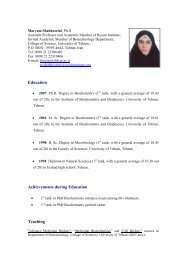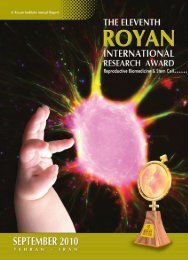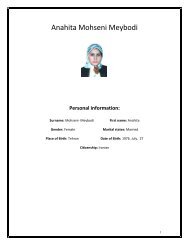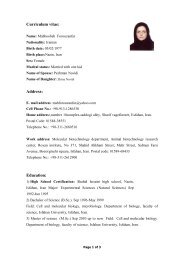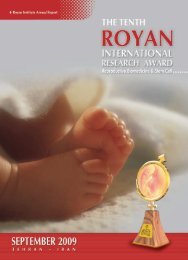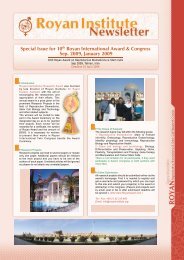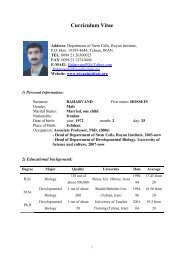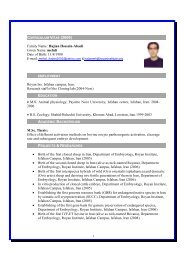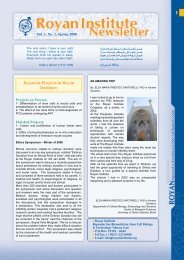Royan Newsletter Vol 3 No 2 Spring 2010 (88-12 ... - Royan Institute
Royan Newsletter Vol 3 No 2 Spring 2010 (88-12 ... - Royan Institute
Royan Newsletter Vol 3 No 2 Spring 2010 (88-12 ... - Royan Institute
Create successful ePaper yourself
Turn your PDF publications into a flip-book with our unique Google optimized e-Paper software.
1<br />
<strong>Vol</strong>. 3, <strong>No</strong>.2, <strong>Spring</strong> <strong>2010</strong><br />
از چرخ به هر گونه همى دار اميد<br />
پس موى سياه من چرا گشت سفيد<br />
وز گردش روزگار مى لرز چو بيد<br />
گفتى كه پس از سياه رنگى نبود<br />
With fate you still hope to trade;<br />
You said no color comes after black,<br />
Passage of time should make you afraid<br />
I said my black hair to white degrade]<br />
Hafiz (1320-1389 A.D)<br />
Granulocyte-Colony Stimulation Factor (G-CSF)<br />
for Treatment of Chronic Lower Limb Ischemic<br />
Patients<br />
Autologous Transplantation of Cultivated Limbal<br />
Stem Cells on Amniotic Membrane in Limbal Stem<br />
Cell Deficiency (LSD) Patients<br />
Finished Projects<br />
Esfahan, Iran - Sep 2009<br />
An Amazing Trip<br />
“…Regarding my trip to Iran, I had a great time. The<br />
conference was thoroughly interesting as was my visit<br />
to the <strong>Royan</strong> <strong>Institute</strong> and the Regenerative Medicine<br />
Centre… Regarding the post-congress tour, it was<br />
truly amazing. Esfahan, Shiraz and Persepolis were<br />
beautiful places to visit and I remember them fondly. I<br />
am also grateful to you all at the <strong>Royan</strong> <strong>Institute</strong> for all<br />
the wonderful friends I was able to make both Iranian<br />
and the international delegates. In particular, I would<br />
like to thank you Kamal for showing us the beautiful<br />
sites of Iran. Best regards,<br />
Dr Sajjad Ahmad, PhD,<br />
<strong>No</strong>rth East England Stem Cell <strong>Institute</strong> and <strong>Institute</strong> of<br />
Human Genetics,<br />
Newcastle University, Bioscience Centre, International<br />
Centre for Life,<br />
Times Square, Newcastle upon Tyne, NE1 4EP, United<br />
Kingdom<br />
Research Projects in <strong>Royan</strong><br />
<strong>Institute</strong>:<br />
Projects on Process<br />
Autologous Transplantation of Bone Marrow<br />
Mononuclear Cell (BM-MNC) With and Without<br />
Evaluation of factors that induce differentiation<br />
of mouse embryonic stem cells to cholinergic<br />
neuron<br />
Three- dimensional & monolayer culture of<br />
chndrocytes isolated from Rat articular cartilage<br />
The effect of superovulation on blastocyst quality<br />
of NMM mouse In Vitro<br />
<strong>Royan</strong> Articles<br />
Reprod Biomed Online. 2009 <strong>No</strong>v;19(5):734-6.<br />
Appropriate timing of uterine cavity length<br />
measurement positively affects assisted<br />
reproduction cycle outcome.<br />
Madani T, Ashrafi M, Abadi AB, Kiani K.<br />
Edocrinology and Female Infertility Department,<br />
Reproductive Medicine Research Centre, <strong>Royan</strong> <strong>Institute</strong>,<br />
ACECR, Tehran, Iran. tmadani@royaninstitute.org<br />
An appropriate and easy embryo transfer has a direct<br />
impact on pregnancy rates. Proper evaluation of the<br />
uterocervical axis and uterine depth are necessary<br />
for suitable embryo transfer. The aim of this study<br />
was to assess the appropriate time for cervical axis<br />
evaluation and uterine measurement. A total of <strong>12</strong>4<br />
<strong>Royan</strong> <strong>Institute</strong><br />
Reproductive Biomedicine Stem Cell Biology<br />
& Technology Tehran, Iran<br />
P.O.Box: 19395 - 4644<br />
Tel/Fax: (+9821) 22310406<br />
E-mail: info@royaninstitute.org
patients undergoing IVF treatment were included in<br />
the study. They were divided equally into two groups.<br />
In group I (62 women), uterine cavity depth was<br />
measured and the uterocervical axis was determined<br />
on day 2 or 3 of the menstrual cycle, and in group II<br />
(62 women) at the time of oocyte retrieval. There was a<br />
statistically significant difference in clinical pregnancy<br />
rates between the two groups (P = 0.006). Thirty-four<br />
women became pregnant in group I (64.2%) versus<br />
19 women in group II (35.8%). In conclusion, uterine<br />
cavity measurement is necessary for suitable embryo<br />
transfer. It seems that the time of measurement<br />
significantly affects clinical pregnancy rate in IVF<br />
cycles. The best time for uterine measurement is on<br />
day 2 or 3 of menstruation.<br />
Biochem Biophys Res Commun. <strong>2010</strong> Jan<br />
1;391(1):329-34. Epub 2009 <strong>No</strong>v 11.<br />
Generation of human induced pluripotent stem<br />
cells from a Bombay individual: Moving towards<br />
“universal-donor” red blood cells.<br />
Seifinejad A, Taei A, Totonchi M, Vazirinasab H, Hassani<br />
SN, Aghdami N, Shahbazi E, Yazdi RS, Salekdeh GH,<br />
Baharvand H.<br />
Department of Stem Cells and Developmental Biology,<br />
<strong>Royan</strong> <strong>Institute</strong> for Stem Cell Biology and Technology,<br />
P.O. Box 19395-4644, ACECR, Tehran, Iran.<br />
Bombay phenotype is one of the rare phenotypes<br />
in the ABO blood group system that fails to express<br />
ABH antigens on red blood cells. <strong>No</strong>nsense or<br />
missense mutations in fucosyltransfrase1 (FUT1)<br />
and fucosyltransfrase2 (FUT2) genes are known to<br />
create this phenotype. This blood group is compatible<br />
with all other blood groups as a donor, as it does<br />
not express the H antigen on the red blood cells. In<br />
this study, we describe the establishment of human<br />
induced pluripotent stem cells (iPSCs) from the dermal<br />
fibroblasts of a Bombay blood-type individual by the<br />
ectopic expression of established transcription factors<br />
Klf4, Oct4, Sox2, and c-Myc. Sequence analyses of<br />
fibroblasts and iPSCs revealed a nonsense mutation<br />
826C to T (276 Gln to Ter) in the FUT1 gene and a<br />
missense mutation 739G to A (247 Gly to Ser) in the<br />
FUT2 gene in the Bombay phenotype under study.<br />
The established iPSCs resemble human embryonic<br />
stem cells in morphology, passaging, surface and<br />
pluripotency markers, normal karyotype, gene<br />
expression, DNA methylation of critical pluripotency<br />
genes, and in-vitro differentiation. The directed<br />
differentiation of the iPSCs into hematopoietic<br />
lineage cells displayed increased expression of the<br />
hematopoietic lineage markers such as CD34, CD133,<br />
RUNX1, KDR, alpha-globulin, and gamma-globulin.<br />
Such specific stem cells provide an unprecedented<br />
opportunity to produce a universal blood group donor,<br />
in-vitro, thus enabling cellular replacement therapies,<br />
once the safety issue is resolved. Copyright © 2009<br />
Elsevier Inc. All rights reserved.<br />
Int J Dev Biol. 2009 Oct 2. [Epub ahead of print]<br />
Feeder- and serum-free establishment and<br />
expansion of human induced pluripotent stem cells.<br />
Totonchi M, Taei A, Seifinejad A, Tabebordbar M,<br />
Rassouli H, Farrokhi A, Gourabi H, Aghdami N,<br />
Hosseini-Salekdeh G, Baharvand H.<br />
Department of Stem Cells and Developmental Biology,<br />
<strong>Royan</strong> <strong>Institute</strong> for Stem Cell Biology and Technology,<br />
ACECR, Tehran, Iran<br />
Although human induced pluripotent stem cells<br />
(hiPSCs) hold great promise as a source of<br />
differentiated cells for vast therapeutic implications,<br />
many obstacles still need to be surmounted before<br />
this can become a reality. One obstacle, a robust<br />
feeder- and serum-free system to generate and<br />
expand hiPSCs in culture is still unavailable. Here,<br />
for the first time, we describe a novel establishment<br />
and maintenance culture technique that uses human<br />
dermal fibroblasts to generate hiPSCs by introducing<br />
four factors, Klf4, Oct4, Sox2, and c-Myc under serumand<br />
feeder-independent conditions. We have used<br />
a serum replacement product, conditioned medium<br />
(CM), or feeder-free medium (FFM) supplemented<br />
with high elevated basic-fibroblast growth factor in the<br />
absence or presence of Matrigel. Our FFM system in<br />
the presence of Matrigel enhanced the efficiency of<br />
alkaline phosphatase-positive colonies at a frequency<br />
at least 10-fold greater than the conventional<br />
method on feeder cells. The established hiPSCs<br />
are similar to human embryonic stem cells in many<br />
aspects including morphology, passaging, surface<br />
and pluripotency markers, normal karyotype, gene<br />
expression, ultrastructure, and in vitro differentiation.<br />
Such hiPSCs could be useful particularly in the<br />
context of in vitro disease modeling, pharmaceutical<br />
screening and in cellular replacement therapies once<br />
the safety issues have been overcome.<br />
ROYAN<br />
International Twin Congress<br />
11 th Congress on Reproductive<br />
Biomedicine &<br />
6 th Congress on Stem Cells Biology<br />
&<br />
Technology<br />
Sep 15 – 17, <strong>2010</strong> - Tehran – Iran<br />
Deadline 10 May <strong>2010</strong><br />
Email: royancongress@gmail.com<br />
2
Some of our invited speakers in 11 th <strong>Royan</strong> Twin International Congress<br />
15 – 17 Sep <strong>2010</strong>, Tehran, Iran<br />
3<br />
Name From Position<br />
Prof. Rudolf Jaenisch<br />
USA<br />
Professor of Biology<br />
Whitehead <strong>Institute</strong> and Dept. of Biology, MIT,<br />
Cambridge<br />
Prof. Stuart Forbes<br />
UK<br />
Centre for Inflammation Research,<br />
Queen’s Medical Res. Ins., Edinburgh<br />
Prof. Richard A. Young<br />
USA<br />
Professor of Biology Member, Whitehead <strong>Institute</strong>,<br />
Yale University<br />
Prof. Sir Ian Wilmut<br />
UK<br />
Centre for Regenerative Medicine,<br />
University of Edinburgh,<br />
Prof. Ahmed Mansouri<br />
Germany<br />
Investigator Max-Planck <strong>Institute</strong>,<br />
Molecular Cell Biology, Gottingen,<br />
Prof. Oscar K. Lee<br />
Taipei<br />
<strong>Institute</strong> of Clinical Medicine, National Yang-Ming<br />
University and Taipei Veterans<br />
Prof. Marius Wernig<br />
U.S.A.<br />
<strong>Institute</strong> for Stem Cell Biology and Regenerative<br />
Medicine, Stanford University<br />
Prof. Gerlinde Wernig<br />
U.S.A.<br />
Pathology Dept. & <strong>Institute</strong> for Regenerative Med.<br />
& Stem Cell Res., Stanford University<br />
Prof. Tobias Cantz Germany Hanover Medical School, Hanover<br />
Prof. Alan Mackay-Sim<br />
Australia<br />
Director, National Centre for Adult Stem Cell<br />
Research, Griffith University<br />
Prof. Miodrag Stojkovic<br />
Spain<br />
Deputy Director of regenerative medicine, Prince<br />
Felipe Research Centre, Valencia,<br />
Prof. Heiner Niemann<br />
Germany<br />
Institut für Tierzucht und Tierverhalten (FAL),<br />
Mariensee,<br />
Prof. John Aplin UK The University of Manchester, Manchester<br />
Prof. Geraldine Hartshorne<br />
UK<br />
Clinical Sciences Research <strong>Institute</strong>, University of<br />
Warwick<br />
Prof. L. Frith UK University of Liverpool,<br />
Prof. Petr Svoboda<br />
Czech Republic<br />
Department of Epigenetic Regulations, <strong>Institute</strong> of<br />
Molecular Genetics , Prague<br />
Prof. Vardhman K Rakyan<br />
UK<br />
Centre for Diabetes, Barts and The London<br />
School of Medicine and Dentistry, London<br />
Prof. Jean Bernard Dubuisson Switzerland<br />
Department of Obstetrics & Gynecology, Faculty<br />
of Medicine, Geneve University,<br />
Prof. Aleksandr A. Popov<br />
Russia<br />
Chief of the Endoscopic Surgery Department,<br />
Moscow<br />
Prof. Jan. Brosens<br />
UK<br />
Imperial College London/Hammersmith Campus,<br />
London<br />
Prof. Enlan Xia Republic of China<br />
Professor and Tutor of Master’s degree at Fuxing<br />
Hospital , Beijing<br />
About IRAN<br />
Shahr-e Sūkhté (Persian: ,شهرسوخته meaning<br />
“Burnt City”), also spelled as Shahr-e Sukhteh and<br />
Shahr-i Shōkhta, is an archaeological site of a sizable<br />
Bronze Age urban settlement, associated with the<br />
Jiroft culture. It is located in Sistan and Baluchistan<br />
Province, the southeastern part of Iran, on the bank<br />
of the Helmand River, near the Zahedan-Zabol road.<br />
A proposal is submitted to include it in the World<br />
Heritage List of UNESCO.<br />
Site<br />
Covering an area of 151 hectares, Shahr-i Sokhta<br />
was one of the world’s largest cities at the dawn of<br />
the urban era. The settlement appeared around 3200<br />
BCE. The city had four stages of civilization and was<br />
burnt down three times before being abandoned in<br />
2100 BCE. The site was discovered in 1967 and has<br />
been continually excavated since the 1970s by Iranian<br />
and Italian archaeological teams; new discoveries are<br />
reported from time to time.
Finds<br />
In December 2006, archaeologists discovered the<br />
world’s earliest artificial eyeball. It has a hemispherical<br />
form and a diameter of just over 2.5 cm (1 inch). It<br />
consists of very light material, probably bitumen<br />
paste. The surface of the artificial eye is covered<br />
with a thin layer of gold, engraved with a central<br />
circle (representing the iris) and gold lines patterned<br />
like sun rays. The female remains found with the<br />
artificial eye was 1.82 m tall (6 feet), much taller than<br />
ordinary women of her time. On both sides of the eye<br />
are drilled tiny holes, through which a golden thread<br />
could hold the eyeball in place. Since microscopic<br />
research has shown that the eye socket showed<br />
clear imprints of the golden thread, the eyeball must<br />
have been worn during her lifetime. The woman’s<br />
skeleton has been dated to between 2900 and 2800<br />
BCE. The oldest known backgammon, dice and<br />
caraway seeds, together with numerous metallurgical<br />
finds (e.g. slag and crucible pieces), are among the<br />
finds which have been unearthed by archaeological<br />
excavations from this site. Other objects found at the<br />
site include a human skull which indicates the practice<br />
of brain surgery and an earthen goblet depicting what<br />
archeologists consider to be the first animation.<br />
The ancient courier<br />
In one of the most recent discoveries from January, a<br />
team of Iranian and British anthropologists, working<br />
on human remains in the city from the 3rd millennium<br />
BC, identified a male camel rider who they believe<br />
was a messenger in ancient times.<br />
Studies of the skeletal remains belonging to the man<br />
reveal evidence of bone trauma, suggesting that he<br />
was a professional rider who most likely spent most of<br />
his life on camel back.<br />
Indications of riding are seen on the right leg bone<br />
of the man, who died at the age of 40 to 45. The<br />
swellings show that he continuously worked as a<br />
professional rider since he was a teenager. There are<br />
blade-shaped swellings on the lower part of the leg<br />
bone which indicate that he used to gather up his right<br />
leg while riding, suggesting that he rode on a large<br />
animal like a camel or ox. Although there is evidence<br />
showing that smaller draft animals were also used<br />
in the Burnt City, the act of gathering up a leg while<br />
riding is something that one does while riding a camel<br />
over long distances. Scientists, then, believe that the<br />
man was probably a courier who traveled regularly on<br />
camelback.<br />
Women’s role<br />
Some paleoanthropologists believe that mothers in the<br />
Burnt City had social and financial prominence. 5000<br />
year-old insignias, made of river pebbles and believed<br />
to belong only to distinguished inhabitants of the city,<br />
were found in the graves of some female citizens.<br />
Some believe the female owners of the insignias<br />
used them to place their seal on valuable documents.<br />
Others believe the owners may have used the seal to<br />
indicate their lofty status in society.<br />
Craftsmanship<br />
Paleopathological studies on 40 teeth unearthed in<br />
the Burnt City’s cemetery show that the inhabitants of<br />
the city used their teeth as a tool for weaving to make<br />
baskets and other handmade products.<br />
“More than 40 teeth lesions have been identified, the<br />
most prominent of which belongs to a young woman<br />
who used her teeth as a tool for weaving baskets and<br />
similar products,” said Farzad Forouzanfar, director<br />
of the Anthropology Department of Iran’s Archeology<br />
Research Center and head of the anthropology team<br />
at the Burnt City in an interview with CHN. The use of<br />
teeth as a tool in the Burnt City is seen in both males<br />
and females of different age groups. Evidence shows<br />
that weaving was more than a hobby in the prehistoric<br />
city. It was one of the most common professions in the<br />
city which required a special skill. Residents made a<br />
variety of woven products such as carpets, baskets,<br />
and other household items.<br />
http://en.wikipedia.org/wiki/Burnt_City<br />
Science News<br />
Stem Cells Made From Developing<br />
Sperm<br />
ScienceDaily (Aug. 7, 2009) — The promise of stem<br />
cell therapy may lie in uncovering how adult cells revert<br />
back into a primordial, stem cell state, whose fate is<br />
yet to be determined. <strong>No</strong>w, cell scientists at the Johns<br />
Hopkins University School of Medicine have identified<br />
key molecular players responsible for this reversion in<br />
fruit fly sperm cells. Reporting online in Cell Stem Cell,<br />
researchers show that two proteins are responsible<br />
redirecting cells on the way to becoming sperm back<br />
to stem cells.<br />
“We knew from our previous work that cells destined<br />
to be sperm could revert back to being stem cells, but<br />
we didn’t know how,” says Erika Matunis, Ph.D., an<br />
associate professor of cell biology at the Johns Hopkins<br />
University School of Medicine. “Since, dedifferentiation<br />
is an interesting phenomenon probably occurring in<br />
a lot of different stem cell populations, we wanted to<br />
know more about the process.”<br />
Like all stem cells, each of the nine stem cells in the<br />
fly testis divides to form two daughter cells: One stays<br />
a stem cell and the other differentiates into an adult<br />
cell, in this case, a sperm cell. To figure out what<br />
might cause sperm cells to revert or dedifferentiate,<br />
Matunis’s research team genetically altered the flies<br />
so that both cells become sperm, reducing the stem<br />
cell population in the testis to nothing.<br />
About a week later, the team examined these fly testes<br />
and found that the stem cells had been repopulated.<br />
To figure out how this was happening, the researchers<br />
first suspected two proteins—Jak and STAT—known<br />
to act together to help stem cells maintain their stem<br />
cell-ness. The team genetically altered flies to reduce<br />
the activity of Jak and STAT in the testis. Counting<br />
the number of cells, they found that the loss of Jak-<br />
STAT caused fewer cells to revert to stem cells; only<br />
60 percent of testes regained stem cells compared to<br />
97 percent in normal Jak-STAT-containing testes.<br />
“We now know that in the fly testis, interfering with<br />
Jak-STAT signaling interferes with the process of<br />
dedifferentiation,” says Matunis.<br />
Next, Matunis would like to figure out how Jak and<br />
STAT control dedifferentiation. “We don’t know if a cell<br />
4
is just reversing all of the steps to go back to being<br />
a stem cell or if it is doing something totally new and<br />
different, but we’re eager to find out,” she says.<br />
Authors on the paper are X. Rebecca Sheng and<br />
Erika Matunis of Johns Hopkins and Crista Brawley,<br />
formerly of Johns Hopkins, now at the University of<br />
Chicago.<br />
http://www.sciencedaily.com/<br />
releases/2009/08/090806<strong>12</strong>1716.htm<br />
D-81369 Munich<br />
www.interplan.de<br />
Phone: +49 (0)89 / 54 82 34 73<br />
Fax: +49 (0)89 / 54 82 34 42<br />
Board of Directors: Bruno Lichtinger, Dr. Markus<br />
Preußner, Dan Rivil, Avi Rosner<br />
Commerical Register: Jurisdiction: Munich,<br />
Registration Number: HRB 134 892<br />
www.IFFS<strong>2010</strong>.com<br />
5<br />
http://www.bentham.org/open/<br />
toanatj/index.htm<br />
The Open Anatomy Journal<br />
ISSN: 1877-6094<br />
Editor-in-Chief: Eimei Sato (Japan)<br />
Associate Editor: Guido Macchiarelli (Italy)<br />
Regional Editor (Europe): Stefania A. <strong>No</strong>ttola<br />
(Italy)<br />
11th Congress of the European<br />
Society of Contraception and<br />
Reproductive Health<br />
May 19-22, <strong>2010</strong><br />
The Hague, NETHERLANDS<br />
11 th<br />
ROYAN<br />
International Research Award<br />
Sep 15 -17, <strong>2010</strong><br />
IFFS Munich <strong>2010</strong> - YES YOU CAN!!<br />
IFFS is proud that in <strong>2010</strong> we celebrate 60 years as<br />
the world´s leading organization devoted to human<br />
fertility and infertility.<br />
Made up of 59 international fertility societies IFFS<br />
standardizes and classifies fertility and infertility<br />
processes all over the world<br />
Come join us in Munich on September <strong>12</strong>-16 for our<br />
20th World<br />
Congress!<br />
IFFS is you: write your abstract now and join us in<br />
Munich.<br />
YES YOU CAN !!<br />
Professor David Healy<br />
Key <strong>No</strong>te Lecture: Safety issues in hormonal therapy<br />
Tuesday 14th September, Alfred O. Mueck, Germany<br />
Congress, Meeting & Event Management AG<br />
Albert-Rosshaupter-Strasse 65<br />
Reproductive Biomedicine<br />
& Stem Cells<br />
Biology & Technology<br />
Deadline 10 April 2008<br />
E-mail: Info@<strong>Royan</strong><strong>Institute</strong>.org



